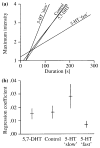Chronic alterations in serotonin function: dynamic neurochemical properties in agonistic behavior of the crayfish, Orconectes rusticus
- PMID: 11891663
- PMCID: PMC4782932
- DOI: 10.1002/neu.10035
Chronic alterations in serotonin function: dynamic neurochemical properties in agonistic behavior of the crayfish, Orconectes rusticus
Abstract
The biogenic amine serotonin [5-hydroxytryptamine (5-HT)] has received considerable attention for its role in behavioral phenomena throughout a broad range of invertebrate and vertebrate taxa. Acute 5-HT infusion decreases the likelihood of crayfish to retreat from dominant opponents. The present study reports the biochemical and behavioral effects resulting from chronic treatment with 5-HT-modifying compounds delivered for up to 5 weeks via silastic tube implants. High performance liquid chromatography with electrochemical detection (HPLC-ED) confirmed that 5,7-dihydroxytryptamine (5,7-DHT) effectively reduced 5-HT in all central nervous system (CNS) areas, except brain, while a concurrent accumulation of the compound was observed in all tissues analyzed. Unexpectedly, two different rates of chronic 5-HT treatment did not increase levels of the amine in the CNS. Behaviorally, 5,7-DHT treated crayfish exhibited no significant differences in measures of aggression. Although treatment with 5-HT did not elevate 5-HT content in the CNS, infusion at a slow rate caused animals to escalate more quickly while 5-HT treatment at a faster rate resulted in slower escalation. 5,7-DHT is commonly used in behavioral pharmacology and the present findings suggest its biochemical properties should be more thoroughly examined. Moreover, the apparent presence of powerful compensatory mechanisms indicates our need to adopt an increasingly dynamic view of the serotonergic bases of behavior like crayfish aggression.
Figures





Similar articles
-
Neuronal adaptations to changes in the social dominance status of crayfish.J Neurosci. 1997 Jan 15;17(2):697-708. doi: 10.1523/JNEUROSCI.17-02-00697.1997. J Neurosci. 1997. PMID: 8987791 Free PMC article.
-
5,7-Dihydroxytryptamine lesions of crayfish serotonin-containing neurons: effect on the lateral giant escape reaction.J Neurosci. 1986 Jun;6(6):1560-9. doi: 10.1523/JNEUROSCI.06-06-01560.1986. J Neurosci. 1986. PMID: 3711995 Free PMC article.
-
Serotonin depletors, 5,7-dihydroxytryptamine and p-chlorophenylalanine, cause sprouting in the CNS of the adult snail.Brain Res. 1993 Oct 1;623(2):311-5. doi: 10.1016/0006-8993(93)91444-w. Brain Res. 1993. PMID: 7693304
-
Amines and motivated behaviors: a simpler systems approach to complex behavioral phenomena.J Comp Physiol A Neuroethol Sens Neural Behav Physiol. 2005 Mar;191(3):231-9. doi: 10.1007/s00359-004-0585-5. Epub 2005 Feb 1. J Comp Physiol A Neuroethol Sens Neural Behav Physiol. 2005. PMID: 15685443 Review.
-
5-HT1A and 5-HT1B receptor agonists and aggression: a pharmacological challenge of the serotonin deficiency hypothesis.Eur J Pharmacol. 2005 Dec 5;526(1-3):125-39. doi: 10.1016/j.ejphar.2005.09.065. Epub 2005 Nov 28. Eur J Pharmacol. 2005. PMID: 16310183 Review.
Cited by
-
Dynamics and mechanics of social rank reversal.J Comp Physiol A Neuroethol Sens Neural Behav Physiol. 2005 Mar;191(3):241-52. doi: 10.1007/s00359-004-0554-z. Epub 2004 Sep 11. J Comp Physiol A Neuroethol Sens Neural Behav Physiol. 2005. PMID: 15372303
-
Affective neuronal selection: the nature of the primordial emotion systems.Front Psychol. 2013 Jan 9;3:589. doi: 10.3389/fpsyg.2012.00589. eCollection 2012. Front Psychol. 2013. PMID: 23316177 Free PMC article.
-
The Sensitivity of the Crayfish Reward System to Mammalian Drugs of Abuse.Front Physiol. 2017 Dec 6;8:1007. doi: 10.3389/fphys.2017.01007. eCollection 2017. Front Physiol. 2017. PMID: 29270131 Free PMC article. Review.
-
Drug-seeking behavior in an invertebrate system: evidence of morphine-induced reward, extinction and reinstatement in crayfish.Behav Brain Res. 2009 Feb 11;197(2):331-8. doi: 10.1016/j.bbr.2008.08.043. Epub 2008 Sep 6. Behav Brain Res. 2009. PMID: 18822319 Free PMC article.
-
Amine neurochemistry and aggression in crayfish.Microsc Res Tech. 2003 Feb 15;60(3):360-8. doi: 10.1002/jemt.10274. Microsc Res Tech. 2003. PMID: 12539165 Free PMC article. Review.
References
-
- Amstislavskaya TG, Kudryavtseva NN. Effect of repeated experience of victory and defeat in daily agonistic confrontations on brain tryptophan hydroxylase activity. Fed Euro Biochem Soc. 1997;406:106–108. - PubMed
-
- Antonsen BL, Paul DH. Serotonin and octopamine elicit sterotypical agonistic behaviors in the squat lobster Munidia quadrispina (Anomura, Galatheidae) J Comp Physiol A. 1997;181:501–510.
-
- Arnold AP, Schlinger BA. Sexual-differentiation of brain and behavior: the zebra finch is not just a flying rat. Brain Behav Evol. 1993;42:231–241. - PubMed
-
- Ase AR, Reader TA, Hen R, Riad M, Descarries L. Altered serotonin and dopamine metabolism in the CNS of serotonin 5-HT1A or 5-HT1B receptor knockout mice. J Neurochem. 2000;75:2415–2426. - PubMed
-
- Austad SN. Game theory and the evolution of animal contests. Trends Ecol Evol. 1989;4:2–3.
Publication types
MeSH terms
Substances
Grants and funding
LinkOut - more resources
Full Text Sources

